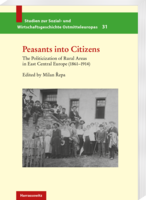|
Bitte beachten Sie: Mit digitalen Produkten in Ihrem Warenkorb
wird die Bezahlung nur per PayPal möglich. Der Download dieser Produkte wird bereitgestellt, wenn die Bezahlung bestätigt ist. Peasants and Citizens explores the processes leading the rural populations of East Central Europe between the mid-nineteenth and early-twentieth centuries to participate in public affairs more actively, by employing a comparative perspective. Seven historians from Europe, the United States, and Japan investigate processes through which civic structures were created in rural areas in the second half of the nineteenth and the beginning of the twentieth centuries. The authors study the factors that led the peasants gain greater confidence in their social position and an interest in politics and detect three key agents of change in the countryside: national movements, agricultural associations, and the extension of the franchise.
These contributions enable us to compare the different conditions leading to developments in the political life in various parts of East Central Europe. For example, while there had been universal male suffrage in Cisleithania since 1907, in Romania only six percent of adult men had a direct vote to the Chamber in 1911. The book extends the study of peasant politicization to territories that have remained rather neglected until now. This applies mainly to the Bohemian lands but also, to a certain extent, to Hungary and Romania. These new findings complement those from the longer tradition of research in this particular field, as in the case of Prussian Poland and Galicia. |
|||||||||||||||||||||||||||||||||||||||||






